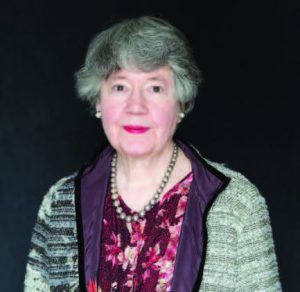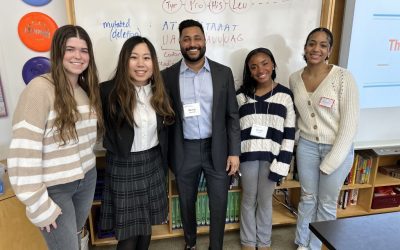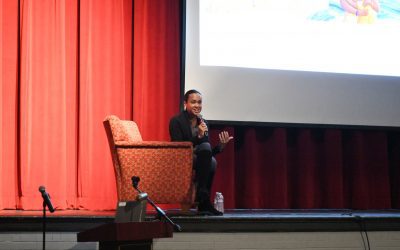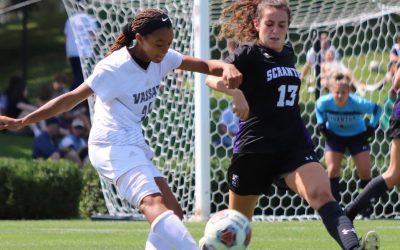“The Lost Year?” A Reflection by Pat Metzer ’59
 School Committee Treasurer Patricia Ann Metzer ’59 penned a reflection on her time spent during the pandemic. Below is an excerpt. You can read Pat’s entire piece online as part of Among Friends Extras at www.mfriends.org. Click on the Alumni section and then “Among Friends Magazine.”
School Committee Treasurer Patricia Ann Metzer ’59 penned a reflection on her time spent during the pandemic. Below is an excerpt. You can read Pat’s entire piece online as part of Among Friends Extras at www.mfriends.org. Click on the Alumni section and then “Among Friends Magazine.”
What does one do in a pandemic – apart from working from home, glued to the computer and socializing over zoom – to top it off with a husband stranded in Europe for over a year? Walking, of course. And where? Well I discovered, of all places, the Cambridge Cemetery, a public cemetery which dates back to before the Civil War. For the first time in my life I watched the seasons pass before my eyes: SPRING with its blossoms, new leaves appearing, and varieties of migrating birds; then SUMMER with new wildlife sightings – a groundhog, chipmunks, black squirrels usually found much further north, and baby rabbits with their fluffy white tails; then on to FALL with its pallet of colorful leaves, and the sighting of a coyote; next WINTER, sometimes with white‑coated landscapes and snowcapped gravestones; and – ah!, once again SPRING, my attention drawn now to the colorful wildflowers and various forms of mushrooms.
I became a birdwatcher too – an activity which knows no seasons. Of course, being a city slicker, I know almost nothing about birds. Like everyone else, I can identify a robin and a sparrow, but I saw birds I have never seen before and I wish I could tell you what they were. I wrote down impressions of what I saw. There were birds of prey and probably woodpeckers; some very small, variously colored birds; and birds with longish, graceful tails. But perhaps the pièce-de–résistance was the “obvious” robin with a white crown – I kid you not. At first, I thought that someone had poured white paint on the bird’s head or that my eyes were deceiving me. I ruled out deception when I came upon what must have been the same bird on two subsequent occasions. And paint did not really seem to be a realistic possibility – so off I went to the bird literature now most readily accessed on, of course, the Internet. Now it turns out that there are indeed white-crowned robins. The problem is that they do not live in the United States and certainly not in Cambridge. They are found in the central, western part of Africa – unless, I guess, they get lost. Do you think my guy got lost and migrated by mistake to Cambridge?
Well, enough about bird watching, because I want to tell you about the most meaningful legacy of my walks – what I came to learn about some individuals who lived over a century ago, whose names appear on memorials scattered throughout the Cambridge Cemetery. As I read and re-read the inscriptions on their memorials, my mind wandered back into the past and my desire to know turned me into Sherlock Holmes. I solved some of the mysteries, others I did not – but I was left with a historical timeline filled with people whose own uniqueness contributed to the world in which we live.
At the start of my timeline – June of 1860, about a year before the start of the Civil War – we find William Loughrey, a patrol officer with the Cambridge Police Department, which erected a memorial in his memory. The memorial tells us that on June 26, 1860, after 14 years of service, Mr. Loughrey was struck down at his post of duty by a burglar at the age of 45. His colleagues wished “to perpetuate his name and commemorate his virtues.” Information on the Internet indicates that he bled to death, leaving behind a wife and four children.
We come next to Rev. William W. Meriam – only one “r”, unlike the author of the dictionary. He was a missionary with the American Board Commissioners for Foreign Missions (the “A.B.C.F.M.”) – which was apparently the first missionary society in the United States, dating back to 1810 and headquartered in Boston. Rev. Meriam’s career took him to Turkey, where his career also ended on July 3, 1862, at the age of 32, when he was murdered by robbers near Uzenjaova. A monument in the cemetery not only tells us this but also tells us that his wife died shortly thereafter in Philippopolis, also at the age of 32. Interestingly, Philippopolis is now known as Plovdiv, Bulgaria but in 1862 it had obviously retained its ancient Greek name and it, as well Uzenjaova, was then part of the Ottoman Empire. A published account of the incident indicates that Rev. Meriam was buried in Turkey and that he and his wife were survived by a daughter, Mary, who must be the Mary whose name appears on the monument in the Cambridge Cemetery.
Two years later, two soldiers who fought in the Civil War lost their lives. In “memory of twin brothers” who lived from 1844 to 1864, a memorial was erected close to what is now the main entrance to the cemetery, with an inscription at the bottom reading: “THE FLAG THEY DIED FOR THANK GOD FLOATS OVER THEIR GRAVES.” William H. Wyeth served in the 1st Massachusetts Cavalry and was killed at Lees Mills, Virginia. His brother, Richard H. Wyeth, a member of the 3rd Massachusetts Cavalry, was killed at the battle of Winchester, Virginia. A monument to the 3rd Massachusetts Cavalry Regiment can be found in the Winchester National Cemetery, indicating “CASUALTIES KILLED AND WOUNDED 207”. I might add here that the Cambridge Cemetery honors veterans whose graves appear in long rows to the left of the main entrance – by placing American flags beside each of them just before Memorial Day. Several months ago I saw that a penny had been placed on each grave as well.
Moving to another part of the Cambridge Cemetery, we find a memorial that records another tragic death that occurred on December 18, 1867 – over two years after the end of the Civil War. A memorial erected to John W. Chapman succinctly states that he was “killed in the terrible railroad accident at Angola N.Y..” My interest was piqued, so I looked around for some information. Recorded accounts of the incident satisfied my curious mind. The story is this. Mr. Chapman was on the Lake Shore Express from Cleveland to Buffalo, returning from a business trip shortly before Christmas, when the last two train cars jumped the tracks while crossing over a high railroad bridge – over which Lincoln’s funeral train had passed several months earlier. The cars, which were lit by kerosene lamps and heated by coal‑burning stoves, fell into the icy gorge below and were consumed by flames. Mr. Chapman was among the nearly 50 passengers who did not survive what was later described as one of the worst train accidents in 19th century America – the “Angola Horror.”
Mr. Chapman met his untimely death in New York State just before reaching his 36th birthday on December 30, 1867. In that same month, Constant Freeman Davis met his untimely death at the age of 24 – just a few days before the Angola train horror – but elsewhere far from home. His memorial tells us that he “DIED ON BOARD THE U.S.S. GUERRIERE IN THE HARBOR OF RIO DE JANEIRO, BRAZIL, DECEMBER 12, 1867”. So this led me to wonder why a U.S. ship was moored in South America just a few years after the end of the Civil War. Turns out that the USS Guerriere was the flagship of a South Atlantic Squadron which was supposed to protect American commerce and interests along the South American coast. She left New York City on June 28, 1867, having been commissioned only a few months earlier, and apparently remained stationed in Rio Janeiro until June 25, 1869, when she set sail for the New York Navy Yard. Only a few years before Mr. Davis’s death, his father, Charles Henry Davis, who had served in the Navy during the Civil War, became one of the founders of the National Academy of Sciences and was promoted to Rear Admiral. Hence, I assume the interesting memorial is now in the Cambridge Cemetery.
Another interesting memorial informs us about the 1st South Carolina Volunteers which during the Civil War was led by Thomas Wentworth Higginson who lived from 1823 to 1911. I certainly did not know that this was the first regiment of African-American “TROOPS EVER REGULARLY ORGANIZED AND MUSTERED INTO THE SERVICE OF THE UNITED STATES”, as the memorial tells us. So again my curiosity was aroused. I found out, among other things, that in the later part of 1862, apparently five African-American infantry units were organized and trained – formed of men who voluntarily chose to fight for the Union in the war. I also learned that after the war, Colonel Wentworth, a Unitarian minister, went on to become an organizer of both the New England Woman Suffrage Association and the American Woman Suffrage Association.
Another prominent advocate of his time is memorialized by a marker that I spent a great deal of time trying to decipher and – finally having figured out what it says – trying to find out about “the Cambridge Holy Ghost Hospital” founded, according to the memorial marker, by Rev. Thomas Scully. When I arrived in Cambridge in 1966, there certainly was no hospital here by the name of “Holy Ghost Hospital” and there is none today. But I found on the Internet a copy of an old postcard – reminded me of the postcards of Atlantic City when I was young – showing a very impressive turn‑of-the-20th‑century building with two wings. After more digging, I located the old building tucked away behind what is now the Spaulding Rehabilitation Hospital, devoid of its former glory – but still with its name “HOLY GHOST HOSPITAL” embossed and the date “1895.” I also found that, although some believe that Rev. Scully was the founder of the Holy Ghost Hospital, others believe it to have been founded by the Sisters of Charity of Montreal as a hospital for the “incurables” – with chronic illnesses and disabilities. No matter! I found Rev. Scully, who lived from 1832 to 1902, to be an interesting person – he fought in the Civil War, successfully guided and led a parish, and advocated temperance. And, by the way, he is buried in Malden, not in Cambridge.
So I think I have said enough now about some of those individuals whose lives I came to know a little bit about over the course of the past year. Like the writers Henry James and William Dean Howells, who were friends and both of whom are buried near one another in the Cambridge Cemetery, these people too are part in our history.
But I cannot leave you without letting you in on another secret. I am not sure you had the privilege of taking road trips across the U.S. with your mother, father, and sibling in a large American car before the invention of air conditioning – with long stretches of boring road and nothing to do. So we played games – looking, for example, for words starting with “A” and so on down the alphabet. The trick was to get to the end of the alphabet before anyone else. I have played similar games on my walks through the Cambridge Cemetery. I try to get an accurate read on the number of grave markers made of rose quartz – but I never seem to get it quite right; maybe there are 19. I am also constantly looking for the oldest grave marker – so far it seems to be that of a man who died in 1818. But that does not seem to make much sense since the cemetery was not founded until years later – I will leave that mystery for another day. I have also been looking for individuals born in the 1770s and those living beyond their 100th year – to date I have found William Houghton, born on March 28, 1771, and Carrie M. Danforth, who was born on October 22, 1866, and died on August 18, 1967.
As a final note: Maybe some of you might have noticed that I titled this essay “The Lost Year?” – intentionally with a question mark. For months on end, I bemoaned my stuck-at‑home fate, hoping for times to return to normal. But I have grown to realize that something very special happened. No longer facing the day‑to‑day pressures of going to the office on the subway, returning home in the evening, only to start all over again the next day – I suddenly was given time to walk at the end of the day in a space where I could reflect on nature and learn of events from the past. I came to understand and appreciate the meaning of peace and tranquility, and the rewards of curiosity. I end this essay with a quote from one of the many grave markers in the cemetery inscribed with verses: “At evening time it shall be light” (January 1, 1896).
Alumni News
Upper School Students Look to the Future at Career Day
Eleventh and twelfth grade students took advantage of the opportunity to network and learn much more about the professional world at the annual MFS Career Day yesterday. Alumni, parents, alumni parents, and friends of the school provided sessions in their areas of...
ABC News Anchor Linsey Davis ’95 Visits MFS for Book Signing
Linsey Davis ’95, ABC World News Tonight Anchor and five-time children’s book author, returned to campus on November 3 to share her most recent book, The Smallest Spot of the Dot, with the MFS community. The day included: an assembly with Lower School students,...
Foxes Alumni Student-Athletes Making Impact in Fall College Seasons
As the Fall sports season winds down at MFS, a number of alumni student-athletes are also in the thick of their NCAA seasons: Ava Carlson ’22 is the starting goalie for the Dartmouth Field Hockey team. She was recently named DartmouthSports.com Athlete of the Week...



